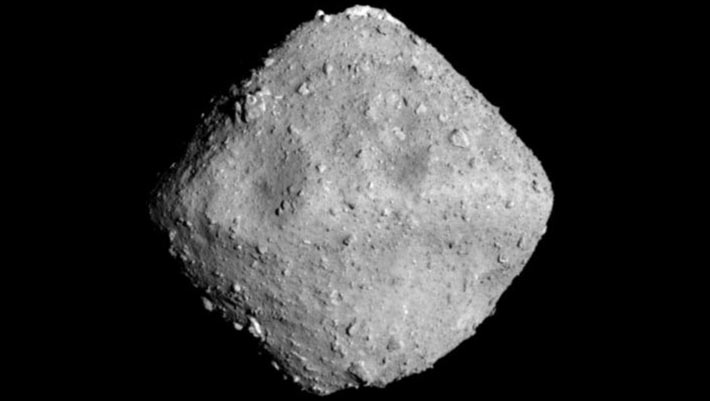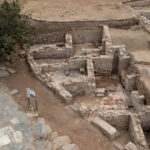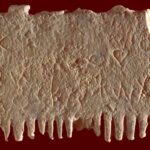The sample of material delivered to our planet from the near-Earth asteroid Ryugu contained a mixture of extraterrestrial (helium and neon) and terrestrial atmospheric gases, according to new research led by Kyushu University scientists.
This image of the asteroid Ryugu was captured by the Optical Navigation Camera – Telescopic (ONC-T) on JAXA’s Hayabusa-2 spacecraft on June 26, 2018, from a distance of 13.7 miles (22 km). Image credit: JAXA / University of Tokyo / Kochi University / Rikkyo University / Nagoya University / Chiba Institute of Technology / Meiji University / Aizu University / AIST.
Ryugu was discovered in May 1999 by astronomers with the Lincoln Near-Earth Asteroid Research.
Also known as 1999 JU3, this asteroid measures approximately 900 m (0.56 miles) in diameter and orbits the Sun at a distance of 0.96-1.41 astronomical units once every 474 days.
JAXA’s Hayabusa-2, a sample-return mission to Ryugu, was launched on December 3, 2014 and arrived at the asteroid on June 27, 2018.
There, the spacecraft deployed rovers and landers onto Ryugu’s surface, and collected samples from near the surface.
On December 6, 2020, a total of 5.4 grams of Ryugu material was returned to Earth in a hermetically sealed sample container within the re-entry capsule.
Thirty hours after atmospheric entry, the gas stored in the container was extracted and measured on-site, and stored in gas collection bottles.
The gas pressure of the container was immediately measured with a pirani gauge and found to be 68 Pa, which is less than 1/1,000 of the Earth’s atmosphere.
“This container gas pressure was about two orders of magnitude lower than the gas pressure inside the sample container returned from the S-type asteroid Itokawa by JAXA’s Hayabusa spacecraft (5,000 Pa),” said Kyushu University researcher Ryuji Okazaki and colleagues.

A carbonate-rich grain in the sample of material from the near-Earth asteroid Ryugu. Image credit: Pilorget et al., doi: 10.1038/s41550-021-01549-z.
Using the quadrupole mass spectrometer (QMS) mounted on the GAs Extraction and Analysis system (GAEA), the researchers measured the major species within the container gas.
Their results revealed that the container gas is a mixture of extraterrestrial helium (He) and neon (Ne) released from the Ryugu grains and contaminant terrestrial atmospheric gases, such as nitrogen (N2) and argon (Ar), which were most likely introduced by a small leak (1.9-2.3 Pa/hour) in the metal sealing system.
“Continuing efforts since before the launch of the Hayabusa-2 spacecraft have allowed us to bring back the asteroidal gas samples from Ryugu to Earth, and have given us an opportunity for measurements,” the scientists said.
“The measured composition of the gas stored in the sample container indicates that the Hayabusa-2 mission has successfully returned solid materials from the surface and subsurface of Ryugu to Earth, with little mechanical and thermal degradation.”
“In this regard, the Hayabusa-2 sample container is a treasure box from a near-Earth asteroid.”
A paper describing the findings was published online October 20, 2022 in the journal Science Advances.
_____
Ryuji Okazaki et al. 2022. First asteroid gas sample delivered by the Hayabusa2 mission: A treasure box from Ryugu. Science Advances 8: eabo7239; doi: 10.1126/sciadv.abo7239




